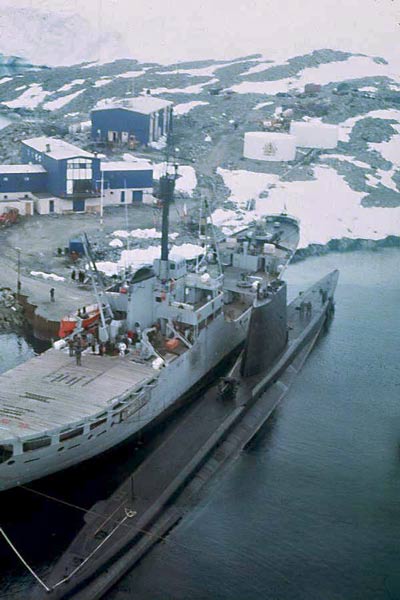|
This was the 2000-ton submarine submarine Simpson, the ex-USS Spot, which originally had been commissioned by the U.S. Navy in 1944. It was transferred to Chile in 1961, although it was not sold outright to Chile (and struck from the US Naval Register) until 1975. It showed up at Palmer Station on 8 December 1979, accompanied by the Chilean Navy icebreaker Piloto Pardo (tied up to the pier in the above photo) and its two helicopters. While the U. S. Navy used the submarine USS Sennet briefly and unsuccessfully during Operation Highjump in 1946-47, this may be the first and only visit of a military submarine to a post-IGY American Antarctic station. The icebreaker Piloto Pardo normally supplied Chile's Antarctic bases and had called at Palmer more than once. The two vessels, along with the Lindblad Explorer, were involved with making the sci-fi film Virus. The film crew and others visited the station, the two vessels took on 25,000 gallons of fresh water(!) from the station pond, and station personnel were given helicopter rides. The Lindblad Explorer had been chartered by the Japanese film company Kanokawa Films; it had a number of movie stars aboard, including Glenn Ford, George Kennedy, and Chuck Connors. That ship did not visit Palmer, but Chuck Connors flew over the station and waved to folks on the ground. Palmer Station was featured in the movie, but the only actual station footage used was a panoramic view of the station from offshore. As for the 1980 movie...I watched it, and my personal opinion is that it is as bad as most other Antarctic-based fictional films. Briefly, it's a dystopian movie involving a virus that was active at temperatures above 14ºF, so it eventually killed everyone on earth except for 800-some folks (including only 8 women--an important plot element) in Antarctica. Some of them are depicted meeting in what is supposedly the lounge/dining room at Palmer Station, from which a surviving British nuclear submarine sails with some of the folks to Washington D.C. After they arrive in DC and start exploring, automated missile systems set off a nuclear exchange with the Soviet Union...like I said, it is a bad movie. For more details about the flick Virus, I recommend this Wikipedia article. Postscripts... #1: while returning north in mid-December, the Simpson rescued the LNG carrier Copernico by towing it away from a lee shore, after the tanker lost power while navigating the western entry of the Straits of Magellan during a storm (the story) (archive page). #2: the Piloto Pardo assisted and rescued passengers from the Lindblad Explorer after that vessel ran aground off Wiencke Island on 24 December. [Information about this rescue, as well as the Palmer Station visit by the film team, is from this article in Antarctic--the journal of the New Zealand Antarctic Society; all archived issues are available here but now available only to paid subscribers.] #3: As we now know, the Lindblad Explorer sank on 23 November 2007 just southeast of King George Island. #4: The icebreaker Piloto Pardo was originally built in the Netherlands for the Chilean Navy in 1959; it was named for Luis Pardo, the captain of the Chilean cutter Yelcho, which had rescued the men from Shackelton's expedition from Elephant Island in August 1916. The Chilean Navy decommissioned the ship in 1997; it was eventually purchased by Antarctic Shipping SA, refurbished for passenger service, and renamed MV Antarctic Dream. After a more recent 2005 refit, it was operated by Oceanwide Expeditions and flagged in Belize. Antarctic Shipping SA suspended operations in 2012, cruises were cancelled, and I haven't been able to determine the vessel's current status. #5: According to Wikipedia, Simpson was significant for being one of he last submarines to have a deck gun. It was disposed of by the Chilean Navy in 1982. The unique photo above is from 1979 Palmer Station winterover and friend Allen Cull, who must have scored one of those helicopter rides. |
